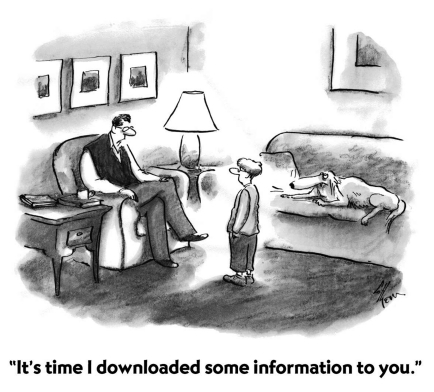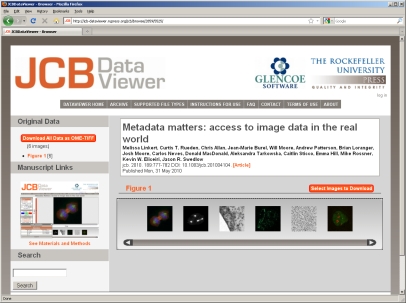The JCB was founded by a group of scientists who needed a journal to showcase their micrographs with the highest quality reproduction. Our commitment to innovative presentation and sharing of image data continues today with the JCB DataViewer.
The JCB was founded by a group of scientists who needed a journal to showcase their micrographs with the highest quality reproduction. Our commitment to innovative presentation and sharing of image data continues today with the JCB DataViewer.
© Frank Cotham, The New Yorker Collection, www.cartoonbank.com
Traditional publication media cannot accommodate the multidimensionality, high resolution, and increasing volume of data produced by current imaging technology. A further barrier to sharing contemporary image data is the variety of proprietary file formats (PFFs) generated by an assortment of microscopes (Linkert et al., 2010). To address these limitations, the JCB developed the DataViewer, a browser-based application that makes original, multidimensional image data, and the associated metadata, from more than 75 different PFFs accessible to readers (Hill, 2008). The DataViewer allows the JCB to host the large amount of data required to accommodate images at the size and resolution at which they were acquired, as well as large image datasets that support quantitative microscopy studies and high-throughput image screens. No other journal has the ability to publish image data in this quantity, quality, or format.
Since its launch in December, 2008, 22% of published papers have included data in the JCB DataViewer, with a total of 4,673 images (comprising 761,407 image frames) posted as of September 1, 2010. Not only is an increasing number of authors voluntarily including these data with their publications, but the number of users has increased dramatically, with ∼15,000 users accessing the JCB DataViewer each month.
We are pleased with this success and are striving to build on it. The JCB DataViewer is under continuous development, and we are delighted to announce a major upgrade to the system.
Analyze this
The updated JCB DataViewer now allows users to download image data and its associated metadata in a standardized format (OME-TIFF; see Linkert et al., 2010), making the data accessible for independent analysis regardless of the file format in which they were acquired. Although the JCB DataViewer already includes some simple data analysis tools, including single-channel viewing and intensity plots, the option to download image data in a standardized format allows users to harness the power of their own image analysis software to examine images associated with published JCB papers. Going forward, images in the JCB DataViewer will be available for download by default. Authors will have the option to turn off this feature if they so choose, but we hope that the community will embrace this new technology to maximize its utility.
This functionality, along with other new features (shown in Box 1), represents an important upgrade for the JCB DataViewer. The combination of a browser-based application with the option to download images and metadata provides a powerful new means of sharing and mining image data. The JCB is committed to the continued development of this technology.
Box 1. New features of the updated JCB DataViewer
Download:
– Download image data files in OME-TIFF format.
– Make-your-own-movie functionality for all multidimensional images.
Upload:
– Batch selection of multiple files in the JCB DataRollup. This is a Java application for the submission of original image data, associated with a JCB manuscript, to the JCB DataViewer.
– More supported file types. We now support more than 75 file types (for a list see: http://jcb-dataviewer.rupress.org/jcb/page/imageformats).
Viewing images:
– Improved user interface for adjusting the rendering settings of an image.
– Application of adjusted rendering settings to multiple images by authors.
– Play movie buttons on all multidimensional images.
Layout:
– New layout for the Archive and Search Results pages, with 10 articles listed per page in reverse chronological order. The Archive page can be navigated by year of publication in the left column.
– Thumbnail display of the relevant figure from the corresponding JCB paper.
– Direct link to the Materials and methods section of the corresponding JCB paper.
Screenshot of the JCB DataViewer, showing the options for downloading image data (see http://jcb-dataviewer.rupress.org/jcb/browse/2859/5525/).
Credit where credit is due
As image-sharing technology continues to develop and becomes more commonplace (see Linkert et al., 2010, Table I), it is essential that the licenses and copyrights attached to images are explicit and are respected by third-party users. This requirement, however, does not have to impede the sharing of image data.
The American Society for Cell Biology (ASCB) has adopted technology similar to the JCB DataViewer for their new image library (www.celllibrary.org), which recently launched in August, 2010. The ASCB Image Library is a potentially valuable image archive and teaching resource, and the JCB would like to contribute images published in the Journal (and in the JCB DataViewer) to the library. However, the ASCB requires images in the library to be placed in the public domain, that is, to be “freely available for everyone, everywhere, to use in any manner for any purpose, commercial or noncommercial, without attribution or restriction” (http://cellimagelibrary.org/pages/contribute). These terms of use violate our policies, which restrict commercial reuse and require attribution for reuse by any third party (http://jcb.rupress.org/site/misc/terms.xhtml). Although the ASCB Image Library has a field for denoting attribution—and suggests that users credit the content provider—the lack of a strict requirement for attribution by those downloading images is a violation of even the most liberal reuse policies (such as those of the PLoS journals: http://www.plos.org/oa/definition.php). This effectively precludes the inclusion of published images in the library.
All major, user-driven, public image libraries, such as Flickr, Picasa, and Windows Live Photos, require users of the site to respect the licenses attached to individual images. A similar policy is in place at the “Cell Centered Database,” the image library of the National Center for Microscopy and Imaging Research (http://ccdb.ucsd.edu/agreement/index.shtm) and the Public Health Image Library of the CDC (http://phil.cdc.gov/phil/faq.asp).
The ASCB’s approach is to refrain from placing any restrictions on the library that will impede data mining, but, as a consequence, they are effectively limiting the content of the library to unpublished images. This policy diminishes the quality of the library, as researchers select their most compelling images for publication. Although the ASCB’s effort to make images publicly available is laudable, its success must be secured by carefully written policies for third-party use, which will allow both data mining and the inclusion of published images.
We have only begun to realize the potential of advanced imaging and image database technology. The JCB will continue to develop this technology to facilitate the sharing of image data from published articles.
References
- Hill E. 2008. Announcing the JCB DataViewer, a browser-based application for viewing original image files. J. Cell Biol. 183:969–970 10.1083/jcb.200811132 [DOI] [Google Scholar]
- Linkert M., Rueden C.T., Allan C., Burel J.-M., Moore W., Patterson A., Loranger B., Moore J., Neves C., Macdonald D., et al. 2010. Metadata matters: access to image data in the real world. J. Cell Biol. 189:777–782 10.1083/jcb.201004104 [DOI] [PMC free article] [PubMed] [Google Scholar]




